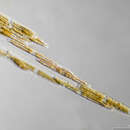tr
kırıntılardaki isimler


Bacillaria ist eine Gattung der Kieselalgen (Bacillariophyta) mit etwa 4 Arten, von denen eine, Bacillaria paradoxa, im Süßwasser, die anderen in Meerwasser vorkommen.
Die Vertreter bilden stark bewegliche Kolonien. Die Zellen haben die für Kieselalgen typische Schale aus zwei Theken. Die Schale ist in Seitenansicht länglich rechteckig, in Schalenansicht linealisch. Über die Schalenflächen sind sie mit ihren Nachbarn verbunden. Sie besitzen zwei plattenförmige Plastiden, die durch Fucoxanthin goldbraun gefärbt sind. Die Plastiden lassen das Zentrum frei, in dem der Zellkern sitzt.
Die ungeschlechtliche Fortpflanzung erfolgt durch die typische Zweiteilung der Kieselalgen. Geschlechtliche Fortpflanzung ist nicht bekannt. Für Bacillaria paradoxa wurde Apogamie beschrieben, die Bildung zygotenähnlicher Stadien ohne Gametenverschmelzung.
Bacillaria paradoxa lebt im Sediment und im Plankton von Süßgewässern, bevorzugt dabei solche mit höherem Salzgehalt. Die übrigen Arten sind Meeresbewohner.
Bacillaria ist eine Gattung der Kieselalgen (Bacillariophyta) mit etwa 4 Arten, von denen eine, Bacillaria paradoxa, im Süßwasser, die anderen in Meerwasser vorkommen.
Bacillaria is a diatom genus in the family Bacillariaceae.[1][2][3]
This genus is photosynthetic, and reproduces sexually and asexually.
Cells are elongated and motile, sliding along each other, in stacked colonies. Cells are rectangular in girdle view (when in colonies), and lanceolate in valve view. Raphe system is slightly keeled and runs from pole to pole. Two large plate-like chloroplasts are present, one near each end of the cell. The nucleus is located centrally. Cells are yellow-brown in colour. Fibulae are strong, and the valve surface is covered in transverse parallel structures called striae.
Video of several diatoms of the genus Bacillaria moving, in real time
Three diatom species were sent to the International Space Station, together with the huge (6 mm length) diatoms of Antarctica and the exclusive colonial diatom, Bacillaria paradoxa. The cells of Bacillaria moved next to each other in partial but opposite synchrony by a microfluidics method.[4]
Length (apical axis[5]): 70 - 200 μm
Width (trans-apical axis):[6] 5 - 8 μm
Height (Pervalvar axis):[7] 5 - 10 μm
Fibulae: 7 - 9 in 10 μm
Striae: 20 - 21 in 10 μm
Benthic zone, marine and brackish/freshwater species, but is also commonly found in plankton.
Bacillaria is a diatom genus in the family Bacillariaceae.
Bacillaria est un genre de diatomées de la famille des Bacillariaceae[1],[2],[3].
Photosynthétique. Reproduction sexuée et multiplication asexuée.
Les cellules sont allongées et mobiles, glissant le long de chacune d'elles empilées dans une colonie.
Largeur ([1] trans-apicale de l'axe): 5 - 8 µm
Hauteur ([2] Pervalvar de l'axe): 5 - 10 µm
Fibules: 7 - 9 à 10 µm
Vergetures: 20 - 21 à 10 µm
Espèce de la zone benthiques, marine et d'eau saumâtre/d'eau douce, mais il est également fréquent de la trouver dans le plancton.
Selon AlgaeBase (11 août 2017)[1] :
Selon Catalogue of Life (11 août 2017)[4] :
Selon ITIS (11 août 2017)[2] :
Selon NCBI (11 août 2017)[5] :
Selon World Register of Marine Species (11 août 2017)[6] :
Bacillaria est un genre de diatomées de la famille des Bacillariaceae,,.
Vidéo de plusieurs diatomées du genre Bacillaria en mouvement, en temps réelBacillaria adalah genus diatom dalam keluarga Bacillariaceae.[1][2][3]
Bacillaria adalah genus diatom dalam keluarga Bacillariaceae.